gRPC, the alternative to REST API

TL;DR
REST is always the go-to architecture when somebody wants to build an HTTP API for communications, in particular with a file format called JSON. This is the new norm, “trending” and common approach, nothing wrong with it. But just because everybody doing it does that make it a legit option when it comes to certain use cases? We all should look at the problem that we are trying to solve first before coming to a decision on which technologies to use. In this article, we are going to discover another option, RPC, specifically gRPC.
What is gRPC?
gRPC is an open sources project developed by Google in 2015 on top of RPC framework. To understand this, you have to know what is Remote Procedure Call(RPC) means. Procedure is also known as functions, it exists in any programming language paradigm.
The term Remote, means that the procedure can be called distributedly by any client/server. Rather than an HTTP call, RPC is a communication that uses a direct function call without co-existing in the same address space.
With the rise of microservices in recent years, RPC started to gain popularity mainly because of how RPC fits into solving microservice problems. Service to service communication happens a lot in microservice, you might also have different services written in a different programming language. With gRPC, it brings performant, and support to help solve the issue.
gRPC supports a number of programming languages. It allows different services to communicate with each other regardless of what programming language each service is written.
Well, I can also achieve these easily by creating REST endpoint from one service and calling this endpoint from another service that used whatever language, as long as I am able to serialize the expected response from this single endpoint right?
Technically yes, but gRPC can save you a lot of work while giving you a performance boost as well!
By default gRPC use protocol buffers as the Interface Definition Language, which are Google’s language-neutral, a platform-neutral mechanism for serializing structured data into bytes of data. All you need to do is just define the data structure of payload message and service interface for communication between services, protobuf (protocol buffers) will generate the source code either for server-side or client-side in whatever language you needed for you to easily write and read the structured data.
But of course, this is limited to the language that gRPC currently supports, but don’t worry most of the most used languages are on the cover. Java, Python, Ruby, Go, C#, and etc, you name it! This is particularly important and beneficial for a distributed systems like microservices when you have different services in different programming languages.
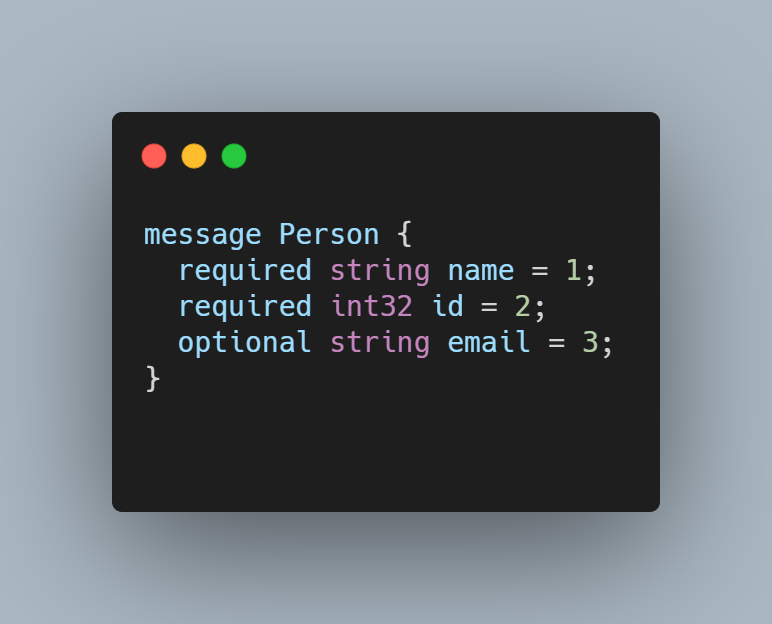
Simple example of defined data structure in protocol buffers language
With the above-defined data structure that you will be creating in .proto file, protobuf will generate the code easily with just simple command which I will showcase later in this article. So yes, this does make your life easier with all the generated codes, but how about the performance buff that I mentioned earlier? Of course, when I talk about performance boost, I am comparing it with the most widely used API architecture, RESTful API. So lets get into a little bit of REST and how’s gRPC better in performance.
REST vs gRPC
As most of us know that REST API which stands for REpresentational State Transfer, is the big boy in the industry, anyone will get in touch with it as long as you are developing something. REST is widely used because of how direct and simple it is. JSON is the most generally popular file format that is used to deliver across HTTP because of its language-agnostic and is also readable by both humans and machines. Besides that, REST follows the HTTP principle, for example, the HTTP methods that we always saw (GET,POST,PUT,DELETE), this brings the advantage of getting more insight into what kind of API endpoint you are dealing with over time to time.
On the other hand, gRPC leverages HTTP/2.0 as its transfer protocol. HTTP2 delivers major enhancement on TCP connection. Below are some of the stand out enhancements for HTTP2 over HTTP1:
- HTTP2 employs binary encoding which is much more efficient for processing compares to HTTP which utilizing plain text.
- HTTP2 adapts the concept of stream, which is fully asynchronous. Client and servers can both initiate multiple streams on a single TCP connection. While HTTP as we know using a single request and response flow which the client had to wait for the server to respond before the next request.
So with gRPC leveraging HTTP2, it also shares the benefits from many advantages mentioned above:
- With protobuf, the data format is transferred in binary format compare to JSON/XML which are text-based, this makes files smaller in size and faster serialization.
- gRPC provides 4 kinds of service methods:
- Unary RPCs, just like REST, the client sends a single request and gets a single response from the server.
- Server streaming RPCs, client send request where the server will return streams of data for the clients to read until there are no more messages left.
- Client streaming RPCs, the client writes a sequence of message and send to the server through streams, it will wait for the server to finish reading and return its response
- Bidirectional Streaming RPCs, both server and client send a sequence of messages using read-write stream. The 2 stream operates independently.
All these perks stated above are every reason why gRPC is faster and efficient compare to REST. How fast? you ask. Take a look at the below figure,
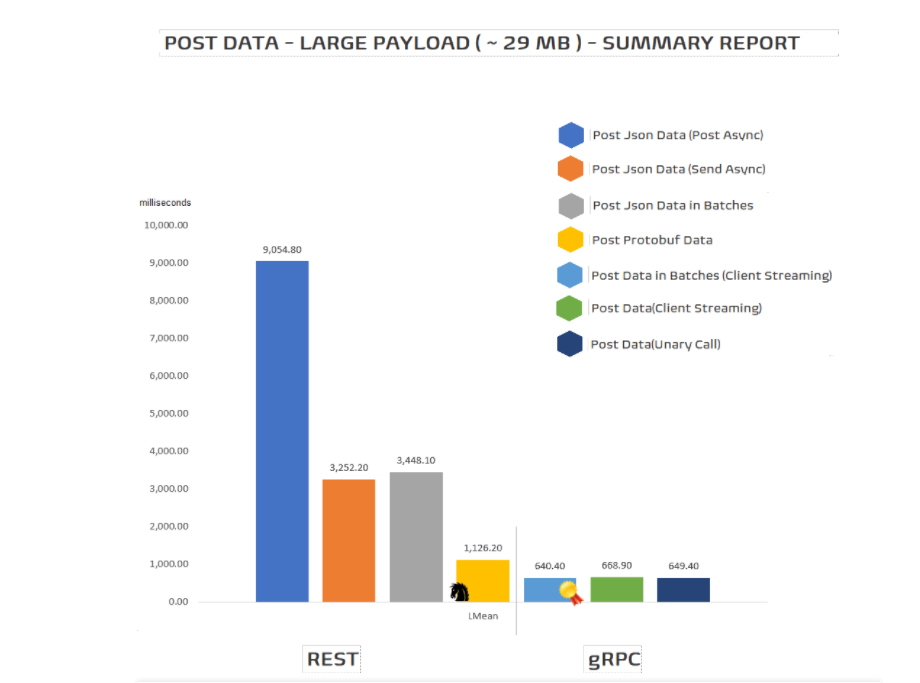
Image Source:linkedin.com/pulse/comprehensive-performanc..
What do we know so far?
We have been talking about what gRPC is and how it is different from REST API, lets redefine the whole thing in a much simpler way to make things much clearer.
- REST API -> work with JSON/XML (text format)
- gRPC -> work with Protobuf message (stream of bytes)
- REST API -> uses HTTP 1.1
- gRPC -> uses HTTP/2
- REST API -> supports request-response model only
- gRPC -> supports request-response, client streaming, server streaming and birectional streaming (took advantage of HTTP/2)
When to use gRPC then?
Like we mention in the beginning, there are no single tools that are able to solve all the problems we faced. Choose your technology wisely based on the problem you are trying to solve.
Although gRPC brings performance in a distributed system, currently it has low browser support because no modern browser can access HTTP/2 frames yet. So REST is still stood out when it comes to a scenario where you need to serve the browser. gRPC is more limited to internal systems.
When real-time streaming calls are what we dealing with, gRPC can fit like a glove to solve the problem as it supports bidirectional streaming as well.
Lastly, thanks to protobuf, which supports code generation for multiple languages, making multi-language communication no issue at all.
Enough for all these theories, let’s dive into the code!
In this article, we will look at how to create a very simple gRPC unary service(request/response) just to have an overall picture of what gRPC looks like.
To showcase one of the edges that gRPC brings which ease multi-language communications between services, we will create a server using Golang and a client using C# for the demonstration.
This is the overall architecture diagram that we are going to build:
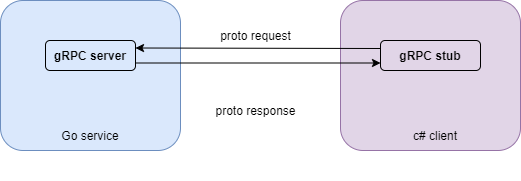
Disclaimer
This tutorial expects you to know at least the basic of golang/dotnet(c#), we will only cover how to create gRPC service, here are some references where you can learn the basics from:
https://golang.org/doc/tutorial/getting-started
https://dotnet.microsoft.com/learn
Creating gRPC Server (Go)
Prerequisites
Before we start, there are packages needed to be installed on your machine.
Protocol Buffers Compiler :
In order to compile the .protoc file, which contains all service and message definitions, we need a protocol buffer compiler to do so.
- For Linux user
$ apt install -y protobuf-compiler
$ protoc --version
For MacOS, use Homebrew
$ brew install protobuf
$ protoc --version
you can also download from here which consists of different releases precompiled binary.
Let’s start with creating a simple gRPC server that is able to send greeting messages to the client that request from the server.
We will use Go Modules for package management. use go mod init projectname to initialize the go.mod file.
go mod init grpc
The protocol buffer compiler requires different plugins for different language code generate, in this case, we are using golang for the server so let’s start by installing the package using go get.
go get -u github.com/golang/protobuf/protoc-gen-go
Now we have the package install, let proceed to write our program start-off point which is our main function with logic that is able to listen on a port for incoming TCP connections:
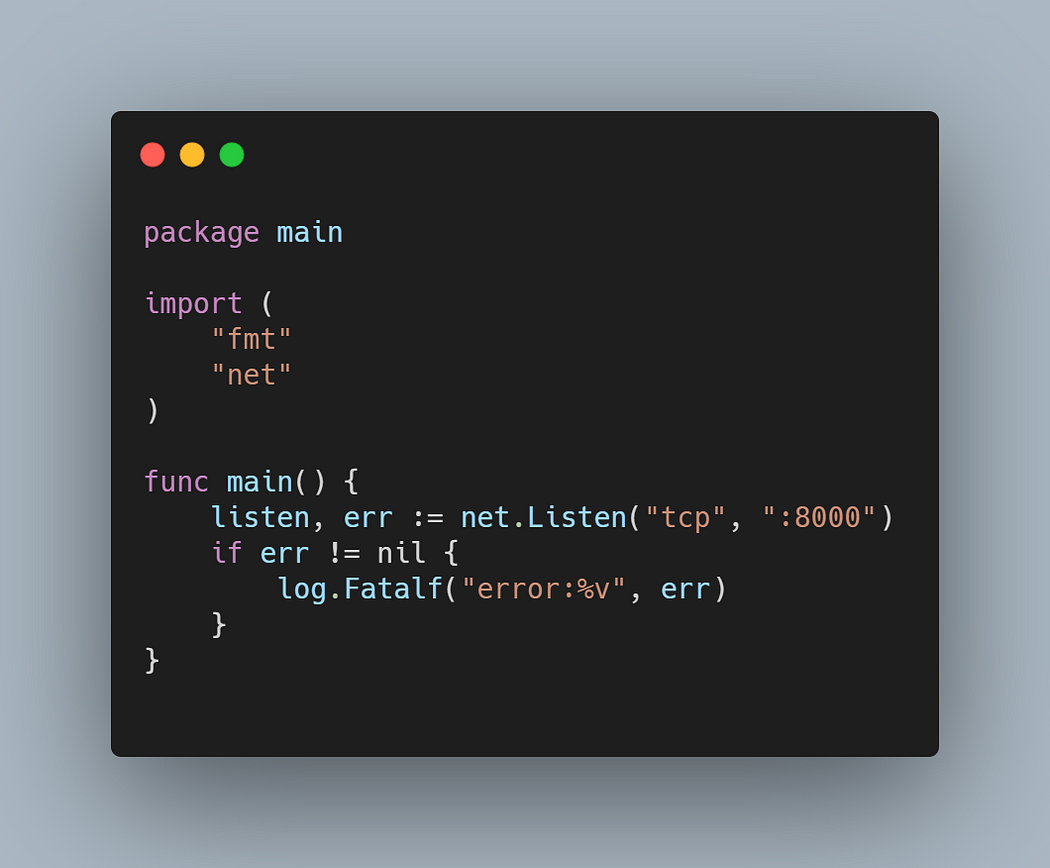
main.go
Next, let’s create the function that our gRCP client can interact with by defining the message and contract in the .proto file. Message referring to the object or model that will be used in the functionality while contract refers to the description of the method or function itself, like what are the arguments expected to call this function and also what return type this function return. Let’s define everything we need for our greeting service in greet.proto file.
Here is the file structure for the proto file:

file structure for protobuf
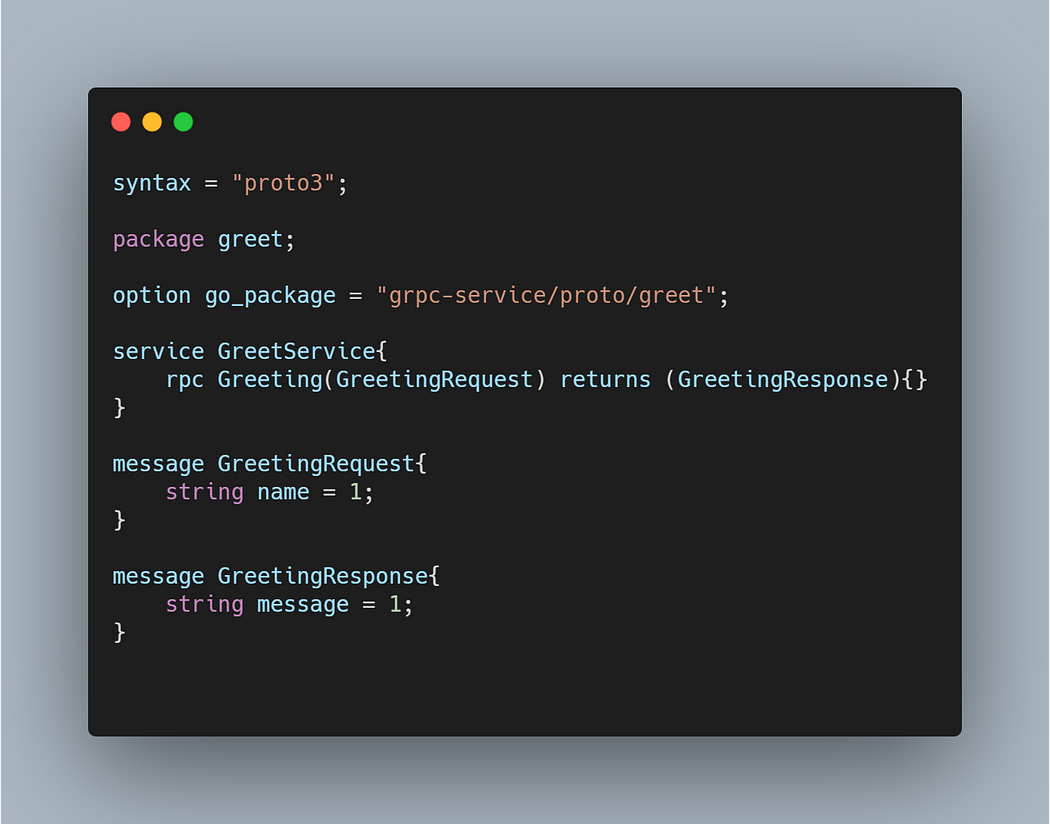
greet.proto
The syntax here refers to the syntax used in this proto file as proto3 syntax. In order to generate the go code from protobuf, we need to define the import path in the .proto file, there are 2 ways to do so, one is like what we are currently doing, we declare it in the .proto file, another way would be declaring it in the command line when invoking protoc. Google official recommended declaring it in the .proto file for simplification. So we can declare it In the file by assigning the path of this package greet. service here referring to the method contract that the client must fulfill in order to call this service and the message descript the request and response object.
With this .proto file created, it exposes the GreetService which consists of our Greeting function that can be called by any gRPC client written in any language.
Once we have our .proto file, this file can share across to any client for their own code generation so that they can communicate with our gRPC server.
Now let’s generate our Go gRPC code using the protobuf compiler that we installed in our machine. To make things easier in environment setup and configuration, we will use make to run the protobuf command. To do so, create a Makefile at the root of your project. Then write down the command below:
generate-protobuf:
@rm -rf grpc-service/${name}/go/** && protoc -I=grpc-service/${name}/proto --go_out=paths=source_relative:grpc-service/${name}/go --go-grpc_out=paths=source_relative:grpc-service/${name}/go grpc-service/${name}/proto/\*.proto
and run the makefile command:
make generate-protobuf name=greet
What the command does is it will first remove any file found inside the file path that we specify, In this case, grpc-service/greet/go/. Noted that the ${name} stands for any variable you input when you run the make command. After removing existing files, we then run protoc by specifying the input folder which tells the protoc where to place our generated code. go_out flag here specify a location for our ’.pb.go’ file which contains code for populating, serializing, and retrieving our GreetingRequest and GreetingResponse, while the go_grpc_out specify the file path for ‘pb.grpc.go’ file which contains generated client and server code. Lastly, we also need to specify the location of our .proto files that protoc will compile.
You’ll see generated file greet_grpc.pb.go and greet.pb.go files generated under the path we had specified.
Now that we have our code generated, is time to call and register the service on our server, let’s do this in our main function:
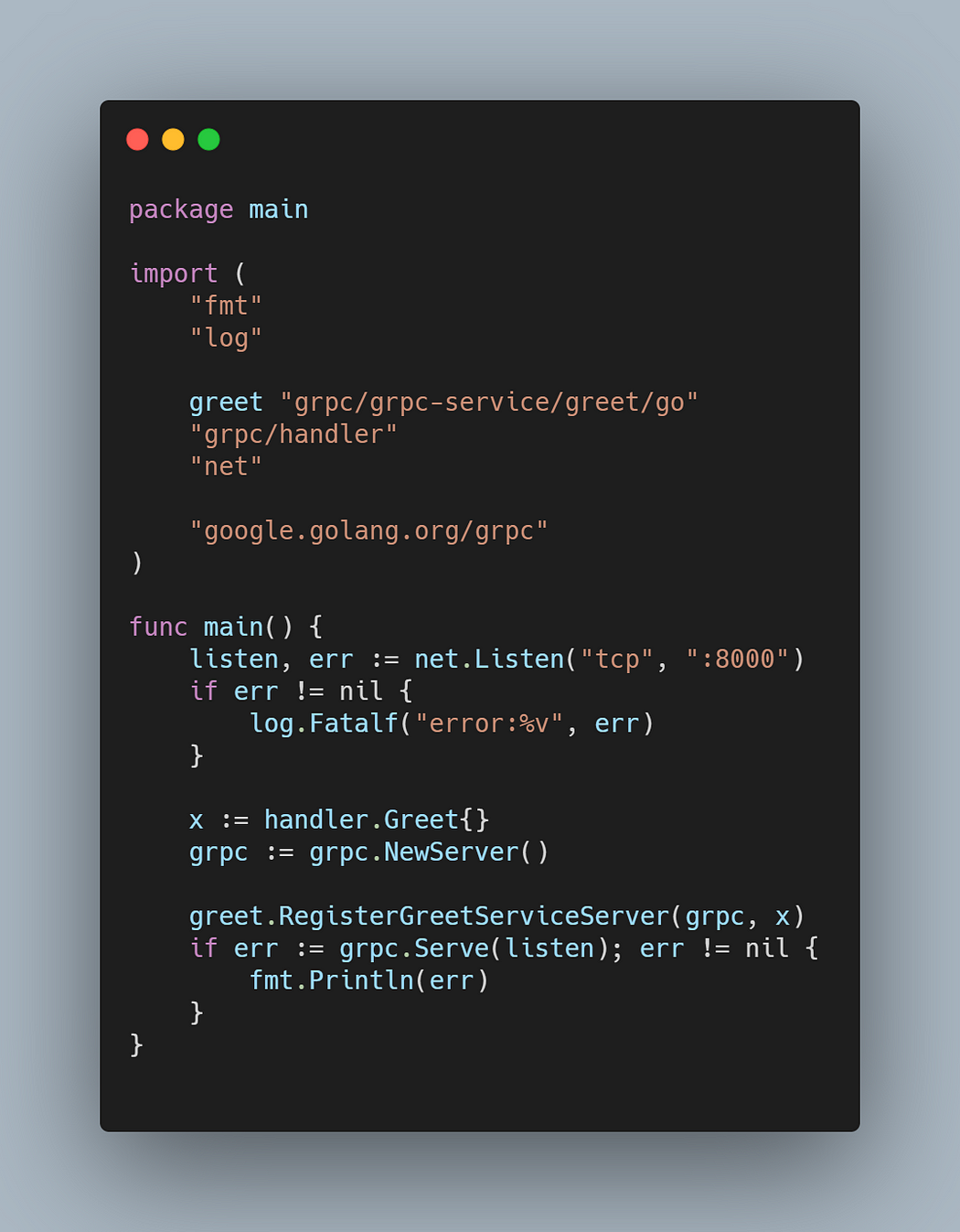
main.go
What we did here is to create a grpc server which has our GreetService registered. As you can see the RegisterGreetServiceServer method is created by protoc to help us register our service to the server, cool right?
So now we had our service registered, what next? What does the service do actually? We do not yet have that defined. This is what we are going to do next, define what Greeting method does.
Create a handler folder which contains a greet.go file.

handler folder
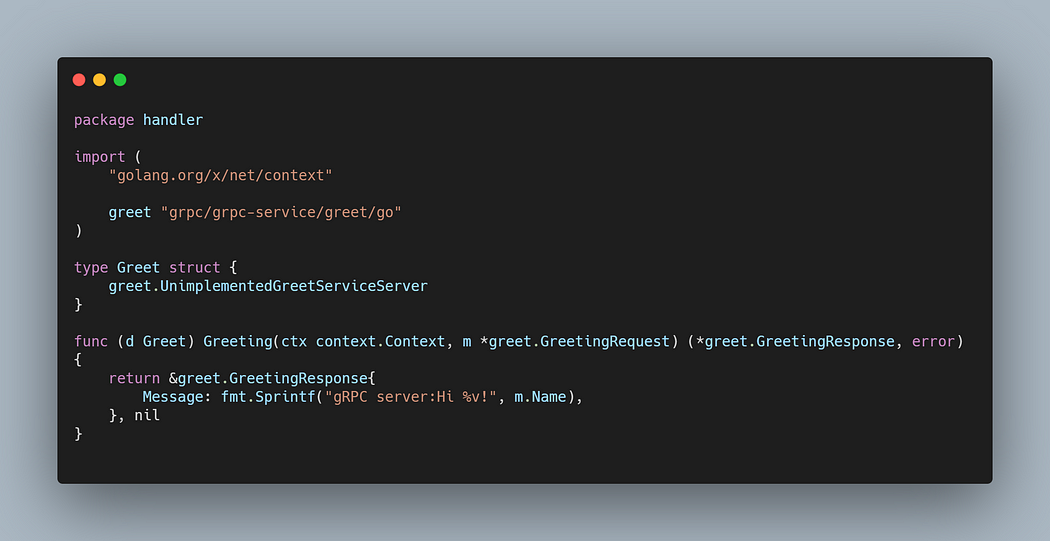
greet.go
Alright, we are all set up for the gRPC server, now let’s run our code:
$ go run main.go
TADAA! Our new gRPC server is now running on localhost:8000.
Creating gRPC Client (.NET 5, c#)
Let us start by create a new .NET gRPC client project.
dotnet new console -o GrpcGreeterClient
code -r GrpcGreeterClient
Prerequisite
you need to have the following package for gRPC client in .NET, run the command below to add:
dotnet add GrpcGreeterClient.csproj package Grpc.Net.Client
dotnet add GrpcGreeterClient.csproj package Google.Protobuf
dotnet add GrpcGreeterClient.csproj package Grpc.Tools
Next, let’s create the greet.proto files under Protos folder.

greet.proto file structure
As I mentioned earlier when we are building the gRPC server, the .proto file can be shared across to any client that which to communicate with the server, so what we going to do now is super simple, just copy and paste the content of greet.proto from our gRPC server to the greet.proto of our client.
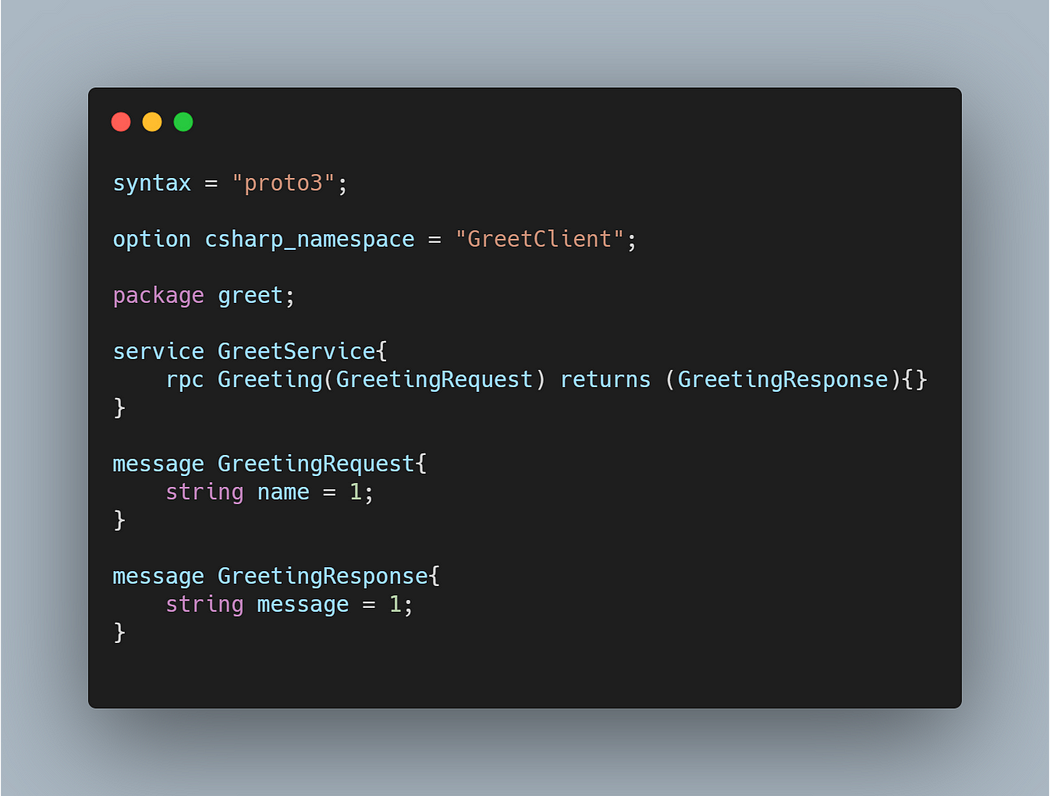
greet.proto
Noted that there do have some minor modifications on the ‘greet.proto’ file, which is our option, we need to update it to our project’s namespace.
Go to the GrpcGreeterClient.csproj project file and add an item group which helps refer the greet.proto file path.
<ItemGroup>
<Protobuf Include="Protos\greet.proto" GrpcServices="Client" />
</ItemGroup>
Now that we have done our gRPC client set up, let’s create the client and eventually call the Greeting method we defined in our gRPC server.
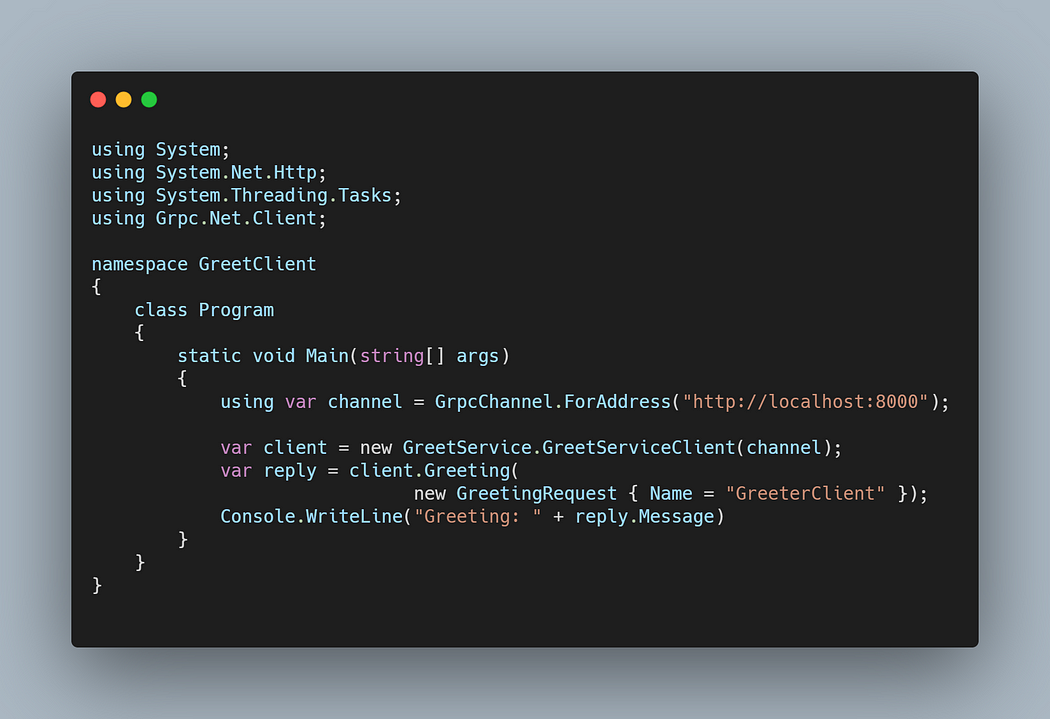
program.cs
Lastly, let’s run build and run the client to see if we can successfully communicate with the server.
$ dotnet run

result
Amazing! We now have a gRPC client that talks to our gRPC server!!
Conclusion
In the nutshell, we can see how gRPC is a great option when comes to microservice architecture, where you have multiple services communicate which each other or environment which involves multi-language communications. My senior once told me, when your server is involved in human communication like feeding data to the UI/frontend to populate, it makes sense to use REST or GraphQL which are more human friendly, but when it comes to machine to machine communication which happens a lot in a microservice architecture, it’s makes more sense to communication with bytes instead of text, because machine talks binary right?